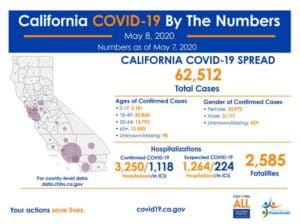The California Department of Public Health today announced the most recent statistics on COVID-19. California now has 62,512 confirmed cases and 2,585 deaths.

Testing in California
As testing capacity continues to increase across the state, the California Department of Public Health is working to expand access to COVID-19 testing. Testing should be used for medical evaluation of persons with symptoms of COVID-19 as well as for efforts by public health agencies and essential employers to prevent and control the spread of COVID-19. Individuals prioritized for testing include:
- Hospitalized patients
- Symptomatic and asymptomatic healthcare workers, first responders, and other social service employees
- Symptomatic individuals age 65 and older or symptomatic individuals of any age with chronic medical conditions that increase the risk of severe COVID-19 illness
- Individuals who are tested as part of disease control efforts in high-risk settings
- Asymptomatic residents and employees of congregate living facilities when needed to prevent disease transmission
- Symptomatic and asymptomatic individuals in essential occupations such as grocery store and food supply workers, utility workers and public employees
- Other individuals with symptoms consistent with COVID-19
As of May 7, 875,272 tests have been conducted in California and reported to the California Department of Public Health. This represents an increase of 32,398 tests over the prior 24-hour reporting period. These numbers include data from commercial, private and academic labs, including Quest, LabCorp, Kaiser, University of California and Stanford, and the 25 state and county health labs currently testing. The Department is now reporting all tests reported in California, rather than the total number of individuals tested.
New Data Portal
The state has launched a new, user-friendly data portal at update.covid19.ca.gov that tracks COVID-19 cases statewide and by county, gender, age and ethnicity. The portal also outlines statewide hospitalizations and testing efforts. The data presented on the portal will be updated daily and will include additional information as it is available.
Racial Demographics – A More Complete Picture
The California Department of Public Health is committed to health equity and collecting more detailed racial and ethnic data that will provide additional understanding for determining future action. Health outcomes are affected by forces including structural racism, poverty and the disproportionate prevalence of underlying conditions such as asthma and heart disease among Latinos and African American Californians. Only by looking at the full picture can we understand how to ensure the best outcomes for all Californians.
The differences in health outcomes related to COVID-19 are most stark in COVID-19 deaths. We have nearly complete data on race and ethnicity for COVID-19 deaths, and we are seeing the following trends. Overall, for adults 18 and older, Latinos, African Americans and Native Hawaiians and Pacific Islanders are dying at disproportionately higher levels. The proportion of COVID-19 deaths in African Americans is about double their population representation across all adult age categories. For Native Hawaiians and Pacific Islanders, overall numbers are low, but about three-fold difference between the proportion of COVID-19 deaths and their population representation. More males are dying from COVID-19 than females, in line with national trends. More information is available at COVID-19 Race and Ethnicity Data.
Health Care Worker Infection Rates
As of May 7, local health departments have reported 6,821 confirmed positive cases in health care workers and 36 deaths statewide.
How People Can Protect Themselves and Others
Every person has a role to play. Protecting yourself and your family comes down to common sense:
- Staying home except for essential needs/activities
- Practicing social distancing.
- Wearing a cloth face mask when out in public.
- Washing hands with soap and water for a minimum of 20 seconds.
- Avoiding touching eyes, nose or mouth with unwashed hands.
- Covering a cough or sneeze with your sleeve, or disposable tissue. Wash your hands afterward.
- Avoiding close contact with people who are sick.
- Staying away from work, school or other people if you become sick with respiratory symptoms like fever and cough.
- Following guidance from public health officials.
What to Do if You Think You’re Sick
Call ahead: If you are experiencing symptoms of COVID-19 (fever, cough or shortness of breath), call your health care provider before seeking medical care so that appropriate precautions can be taken.
For more information about what Californians can do to prevent the spread of COVID-19, visit covid19.ca.gov.
California continues to issue guidance on preparing and protecting California from COVID-19. Consolidated guidance is available on the California Department of Public Health’s Guidance web page.


Hello. Has the California stay at home order been lifted? Govenor Newsom hasn’t mentioned any continued dates? Do high risk people as myself still stay home even though counties are lifting stay home orders? How are we going to protect essential workers like myself if we are already high risk and off work right now because our company cannot accommodate with the social/physical distancing or 6ft rule?? Am i entitled to stay home if i dont want to be around sick people?
Thank you Governor Newsom
for using scientific data to guide your decisions.